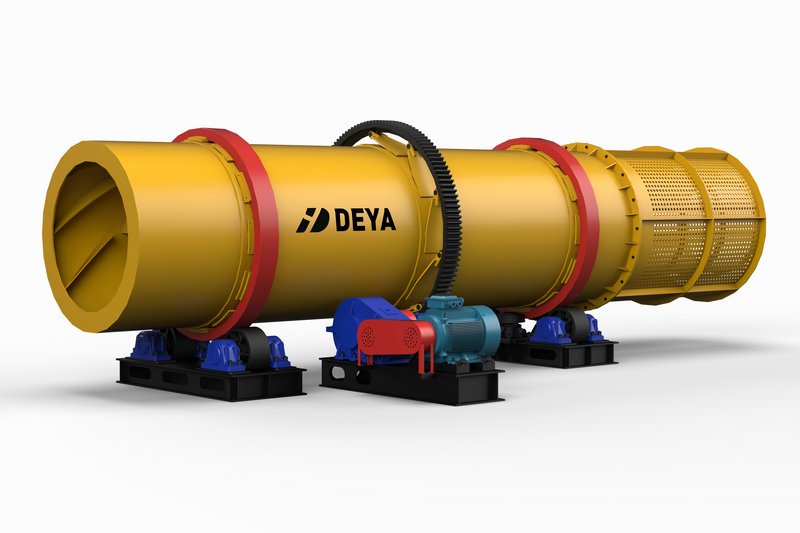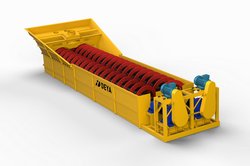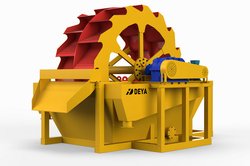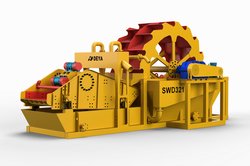Introduction
Rotary scrubbers are used to wash crushed rock, ore, sand, gravel, construction aggregates and oil sands. They are high-capacity, high-retention machines that can accept large-sized feed material and are used primarily to remove water-soluble clays, deleterious materials and coatings providing a cleaner product.
Rotary scrubbers are designed primarily for the removal of loam and light clays and soft, soluble waste materials from aggregates, stone and ore. When these tough clays are fed to a scrubber, the clay particles may have a tendency to pelletize through the tumbling action of the material.
Comparing with a screw washer, the major difference is that rotary scrubbers can accept larger feed sizes, whereas screw washers must have a controlled top size.
Types of rotary scrubber
• A solid shell rotary scrubber is used to remove water soluble clays, deleterious materials and coatings from crushed or natural rock. A single or double shell trommel extension can be added to dewater the material and provide a rough separation of material sizes.
• A combination scrubber screen is part solid shell scrubber and part trommel screen. These units wash, dewater, and screen material more efficiently than a trommel extension. The length of the solid shell and trommel area are designed according to the application.
• A rotary trommel consists of a full-length screening area designed to remove fines from a slurry and/or wash coarse size material.
Working principle
Rotary scrubbers are cylindrical drums with internal lifters, typically supported by trunnion rollers at either end. The continuous lifting and dropping action combined with water helps to abrade, scrub, and break down soluble contaminants. Optional trommel screen extensions can be added to provide rough product separation, screening and dewatering capabilities.
Features of rotary scrubber
1. All the seams on a solid shell scrubber are welded to withstand the continual shock loading
2. The drum integrates abrasion-resistant steel or thick rubber liners, which are secured into the scrubber drum to prevent wear and drum leakage
3. Integral lifter shelves can be modified to increase or decrease cylinder retention time
4. Independently adjustable trunnion rollers support the cylinder end, which are equipped with renewable steel tires
5. Three drive types: chain and sprocket, friction, gear and pinion
6. Trommel Screen extensions with robust cylinder design and construction use easy-to-replace screen panels, including urethane, rubber, punch plate or wire cloth media
7. Fully guarded around pinch points
8. All lubrication points brought into common lubrication blocks
9. Three and four point suspensions available
10. Optional feed end de-sanding section is available
Why rotary scrubber
The continuous lifting and dropping action in rotary equipment helps abrade, scrub and break-down soluble contaminates in the feed material.
Rotary Scrubbers can handle large feed sizes and high tonnages in comparison to other types of washing equipment. As an added benefit, they are lower in operating and maintenance costs.
Technical data
| Model | GXS1048 | GXS1260 | GXS1580 | GXS1890 | GXS2010 | GXS2214 |
|---|---|---|---|---|---|---|
| Drum diameter(mm) | 1000 | 1200 | 1500 | 1800 | 2000 | 2200 |
| Length(mm) | 4800 | 6000 | 8000 | 9000 | 10000 | 14000 |
| Rotation speed(r/min) | 15-30 | 10-25 | 10-25 | 8-22 | 8-22 | 6-17 |
| Capacity(T/H) | 30-50 | 40-70 | 100-160 | 180-250 | 250-350 | 300-500 |
| Power(KW) | 11 | 15 | 22 | 30 | 37 | 45 |
| Length(m) | 6212 | 7250 | 8320 | 9380 | 10500 | 14600 |
| Width(m) | 1350 | 1560 | 1860 | 2220 | 2430 | 2640 |
| Height(m) | 1550 | 1700 | 2150 | 2510 | 2860 | 2950 |
| Weight(Ton) | 5.3 | 8.5 | 11.5 | 17.5 | 22.3 | 31.5 |
Note: According to different materials, feed size and other factors, the results will be different. Contact Deya team for more information.





